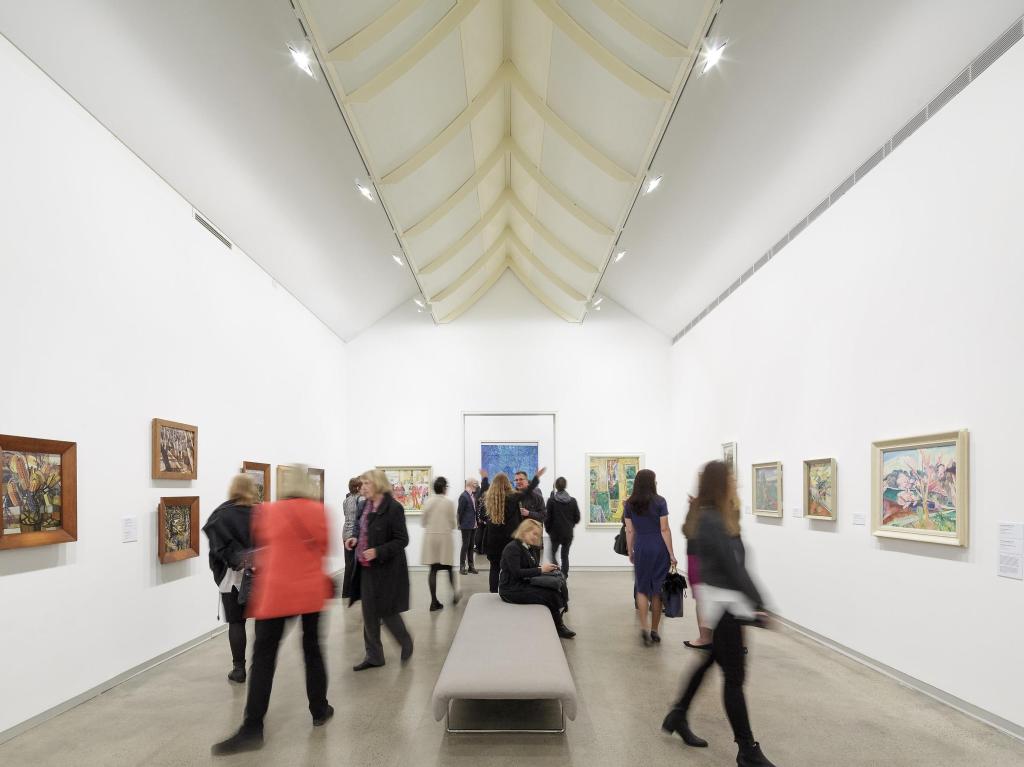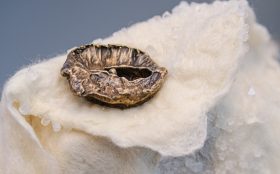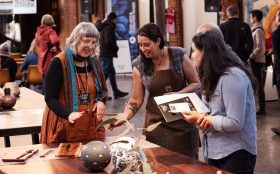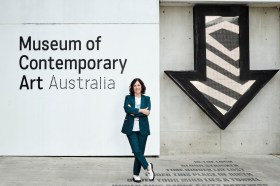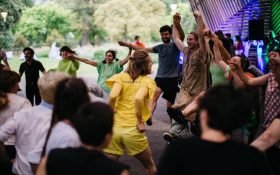Installation view, O’Keefe, Preston, Cossington Smith: Making Modernism. All images used with permission Heide Museum of Modern Art.
It is a busy time of day at the Heide Museum of Modern Art; in the spacious surrounds of Heide III the lively chatter and banter of school children and other visitors can be heard. Amid the ambient noise it takes time to realise that on the walls around the gallery another conversation, just as boisterous, is taking place. Suddenly the bold forms of still life painting Implement Blue, (1927) oil on canvas, by Australian artist Margaret Preston, draws attention; cups, saucers, drinking glasses and jug sit smugly in precise rows, their paired down forms and flattened planes mirrored by a pattern of reflections and shadows that chug to life, machine-like, signaling to its counterpart on the far wall. The Window, (1956) an oil on canvas by Grace Cossington Smith, also Australian, throbs and pulses in response, rhythms of the jazz age almost audible in its vivid colours and impressionistic brush strokes that jump from the flattened picture plane, drawing the viewer into its interior scene and garden beyond.
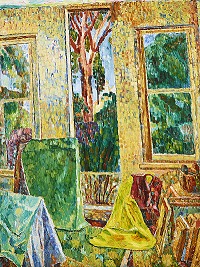
Grace Cossington Smith, The window, 1956.
Although the rhythm has changed, the discourse continues into the second of the two main spaces where paintings by American artist, Georgia O’Keeffe stand in quiet defiance. Petunia No. 2, (1924), a delicate oil painting of a flower, quietly echoes the flattened picture planes and paired down, abstracted forms of the works in the front room. The flower’s curvaceous lines both lyrical and feminine draw the viewer’s attention to the detail and beauty of nature so often missed in the rush of life.
The success of this exhibition lies in its vision and attention to detail. Despite the throng of groups bustling to view the works, good design allows easy flow leaving the visual narrative uninterrupted. Lesley Harding, Heide Museum of Modern Art and her co-curators from the Art Gallery of New South Wales, the Queensland Art Gallery and The Georgia O’Keeffe Museum, Santa Fe have put together an exhibition that explores the artistic development and shared vision of these artists through choice examples of their work. Although each artist’s development is presented in a linear manner around the walls, their voices call across the spaces; there is a shared sentiment and drive that connects these women beyond continents and a vision that defies gender stereotyping and the cultural and artistic norms of their day.
Rejecting realism and traditional modes of expression, these women – whose only connection was their modernist ideology – embraced the wave of philosophical, cultural and social change sweeping the western world in the late nineteenth and early twentieth centuries, giving rise to the modernist movement. In an era of rapid industrial and technological development, these artists found new ways of seeing; exploring light, colour and subject matter such as the still life, landscapes – both natural and industrial – as well as the domestic with a fresh and uncompromising eye; each bringing her own unique cultural and personal experience to the larger modernist picture.

Margaret Preston, Aboriginal Flowers, 1928.
Preston’s Hibiscus, (1929) and Aboriginal Still Life, (1940), both oil on canvas, capture something of her evolving modernist and nationalist style of picture making. Minimalizing the picture planes and limiting the colour range she captures a beauty in the everyday, incorporating indigenous influences that later came to dominate her work.
The evolution of Cossington Smith’s work is seen largely through her landscapes and later interior scenes. Like Preston, she was heavily influenced by the colour theories of the day, infusing her images with light, her painterly marks dancing on the canvas surface. Works such as The Bridge in Building (1929), oil on pulpboard and Bulli Pier, South Coast, (1931) also oil on pulpboard, capture this delight in mark-making and interrogating the surface of her medium; the forms of her later works in Gum Blossom and Drapery, (1952) and Interior with Wardrobe Mirror, (1955) reflect the diminishing importance of subject matter to the exuberance of the brush work and light.
O’Keeffe too delighted in capturing nature and the world around her. Her vision however reflects a more spiritual dimension as seen in earlier close ups and abstractions like Blue Line, (1919) and Corn, No.2, (1924) in which the painted forms and carefully blended tones draw the viewer’s attention to a point of calm reflection. Like her fellow modernists she celebrated the beauty found in the unnoticed of daily existence. The paintings of the New Mexico landscape, the muse of her later years and work, continue this ponderous vision but also reflects a humour as she explores new ways of seeing her environment. Works such as Pelvis IV, (1944) and In the Patio VIII, (1950), capture something of the precise, minimalist vision of her desert surrounds.
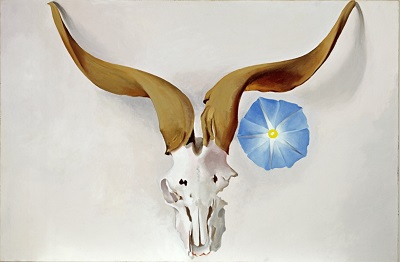
Georgia O’Keeffe, Ram’s Head, Blue Morning Glory, 1938.
Well positioned display tables housing additional interpretive material such as books, sketches and photographs along with didactic panels support the conversation between the works and the viewer: a video in a side gallery providing fascinating footage of O’Keefe and her life in New York and New Mexico. Three years in the making this travelling exhibition provides a long awaited opportunity to experience a greater body of Georgia O’Keeffe’s work and give meaningful context to the Australian artists of the time as well as the bigger modernist picture. This is an exhibition to see!
Rating: 4 stars out of 5
O’Keefe, Preston, Cossington Smith: Making Modernism
12 October 2016 – 19 February 2017
Heide III: Central Galleries
Heide Museum of Modern Art, Bulleen
www.heide.com.au
